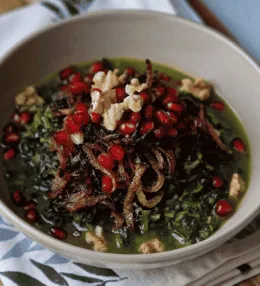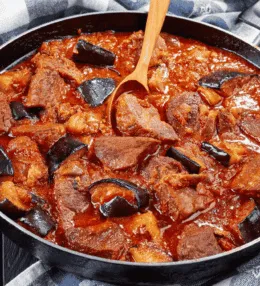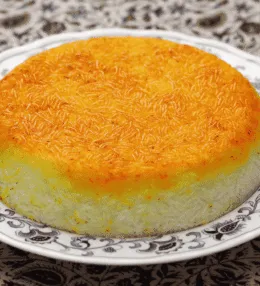
- View
Table of Contents
ToggleGinataang Bilo-Bilo is one of those dishes that makes you slow down for a moment. Warm and creamy with coconut milk, this Filipino favourite is a sweet stew that brings together soft sticky rice balls, root crops, and fruit in a way that feels both hearty and indulgent.
In the Philippines, this dish is often enjoyed in the afternoon when the day is settling down. It is thick, fragrant and colourful, with chunks of plantain, purple yam and jackfruit lending a balance of flavour and texture to the milky base.
The experience of eating Ginataang Bilo-Bilo lies as much in its texture as in its taste. The chewy rice balls float like little pearls while the soft fruit and velvety coconut give it a character that feels close to home.
Want to dive deeper into Filipino Cuisine? Don’t miss our post on 28 Traditional Filipino Foods to Try
What Is Ginataang Bilo-Bilo?
Ginataang Bilo-Bilo is a dessert stew made with glutinous rice balls cooked in coconut milk along with sliced plantains, sweet potato, taro and often ripe jackfruit. The word ginataan refers to any dish cooked with coconut milk.
The rice balls known as bilo-bilo are formed from glutinous rice flour and water, shaped by hand into small rounds that become tender yet chewy when simmered. They are what give the dish its playful texture.
It is usually served hot but can also be eaten at room temperature. Some people enjoy it thick and filling, while others prefer a lighter version with more coconut milk to drink with a spoon.
Ingredients and Taste
The key ingredient is coconut milk which forms the base of the dish. This rich and naturally sweet liquid carries the other flavours, wrapping the starchy root vegetables and soft fruit with a creamy smoothness.
Bananas or plantains add a mellow sweetness. Purple yam and taro give a nutty note, while jackfruit adds perfume and depth. The glutinous rice balls provide a soft chew that sets off the creaminess of the coconut.
The flavour is both sweet and gentle with a natural richness from the coconut. It is not overly sugary, instead letting the fruit speak for itself. Every spoonful is different, with a balance of chew, cream and bite.
A Taste of History
Ginataang Bilo-Bilo comes from a long tradition of using coconut milk in Filipino cooking. Coconut trees thrive across the islands, and their milk and cream are used for both savoury dishes and sweets that bring families together.
It is believed that the roots of this dish are in home kitchens where ingredients were simple. Glutinous rice, tubers and coconut milk were combined into a warm bowl that could feed a household with little effort.
Over time it became a staple for merienda, the Filipino afternoon snack, especially when family and neighbours gather during the rainy season. Its warmth and richness are often linked to comfort and togetherness.
Today, Ginataang Bilo-Bilo continues to hold that same charm. Whether served in a humble village kitchen or during a festive family celebration, it represents more than just a dessert. It carries a memory of community and shared sweetness.
How to Make Ginataang Bilo-Bilo
Ginataang Bilo-Bilo is a comforting Filipino dish of sticky rice balls simmered in sweet coconut milk with root vegetables and tropical fruit. Creamy and fragrant, it is served warm and carries a balance of soft, chewy, and silky textures. See the recipe card at the bottom for printable directions
Ingredients
For the sticky rice balls (bilo-bilo)
- 200 g glutinous rice flour
- 180 ml water
For the coconut base
- 800 ml coconut milk
- 250 ml coconut cream
- 100 g sugar (adjust to taste)
- 1 pinch of salt
For the filling
- 200 g saba bananas (or plantain), sliced into thick coins
- 150 g sweet potato, peeled and cubed
- 150 g purple yam (ube), peeled and cubed
- 150 g taro, peeled and cubed
- 200 g ripe jackfruit strips
Cooking Instructions
Step 1: Make the sticky rice dough
To begin, mix glutinous rice flour and water in a bowl until a soft dough forms. Pinch off small pieces and roll them into marble sized balls. Keep them on a tray and cover with a damp cloth. Move to prepare the coconut base.
Step 2: Start the coconut mixture
In a large heavy bottomed pot, combine coconut milk, sugar, and salt. Heat gently over medium flame until the sugar dissolves. Stir occasionally to prevent scorching. Prepare to add root vegetables.
Step 3: Cook the root vegetables
Add cubed sweet potato, taro, and purple yam to the coconut mixture. Simmer for 10–12 minutes until the cubes are nearly tender but not breaking apart. Transition to adding sticky rice balls.
Step 4: Add the sticky rice balls
Gently drop the shaped rice balls into the simmering coconut mixture. Stir lightly to stop them sticking to the bottom. Cook until the balls float to the surface, showing that they are cooked through. Move to the next flavour layer.
Step 5: Add bananas and jackfruit
Add sliced bananas and jackfruit strips. Continue simmering for 5–7 minutes, letting the fruit soften and infuse their flavour into the coconut broth. Then prepare to finish the dish.
Step 6: Enrich with coconut cream
Pour in the coconut cream to thicken the texture. Stir gently and cook for another 5 minutes on a low flame. Adjust sweetness if needed at this stage. Continue to final step.
Final step: Serve warm
Ladle Ginataang Bilo-Bilo into bowls while still warm. Serve as a snack or dessert. Presentation tip: Garnish with extra jackfruit or a drizzle of coconut cream for a richer look.
Variations and substitutions
- Substitute saba bananas with firm plantains or regular bananas if needed.
- Jackfruit may be replaced with canned jackfruit in syrup (rinse before use).
- Purple yam can be swapped with extra sweet potato where ube is unavailable.
- Coconut cream can be replaced with thick canned coconut milk if fresh is not available.
- Some versions add cooked sago pearls for extra texture.
Cooking Tips for Perfect Ginataang Bilo-Bilo
- Roll the rice balls evenly to ensure even cooking.
- Keep the simmer gentle so the coconut milk does not split.
- Use a heavy bottomed pot to avoid burning the coconut base.
- Add fruit towards the end to keep their shape and fresh taste.

Filipino Ginataang Bilo-Bilo (Sticky Rice Balls in Coconut Milk)
Ingredients
For the sticky rice balls (bilo-bilo)
- 200 g glutinous rice flour
- 180 ml water
For the coconut base
- 800 ml coconut milk
- 250 ml coconut cream
- 100 g sugar adjust to taste
- 1 pinch of salt
For the filling
- 200 g saba bananas or plantain, sliced into thick coins
- 150 g sweet potato peeled and cubed
- 150 g purple yam ube, peeled and cubed
- 150 g taro peeled and cubed
- 200 g ripe jackfruit strips
Instructions
- To begin, mix glutinous rice flour and water in a bowl until a soft dough forms. Pinch off small pieces and roll them into marble sized balls. Keep them on a tray and cover with a damp cloth. Move to prepare the coconut base.
- In a large heavy bottomed pot, combine coconut milk, sugar, and salt. Heat gently over medium flame until the sugar dissolves. Stir occasionally to prevent scorching. Prepare to add root vegetables.
- Add cubed sweet potato, taro, and purple yam to the coconut mixture. Simmer for 10–12 minutes until the cubes are nearly tender but not breaking apart. Transition to adding sticky rice balls.
- Gently drop the shaped rice balls into the simmering coconut mixture. Stir lightly to stop them sticking to the bottom. Cook until the balls float to the surface, showing that they are cooked through. Move to the next flavour layer.
- Add sliced bananas and jackfruit strips. Continue simmering for 5–7 minutes, letting the fruit soften and infuse their flavour into the coconut broth. Then prepare to finish the dish.
- Pour in the coconut cream to thicken the texture. Stir gently and cook for another 5 minutes on a low flame. Adjust sweetness if needed at this stage. Continue to final step.
- Ladle Ginataang Bilo-Bilo into bowls while still warm. Serve as a snack or dessert. Presentation tip: Garnish with extra jackfruit or a drizzle of coconut cream for a richer look.
Nutrition
You May Also Like







Leave a Review